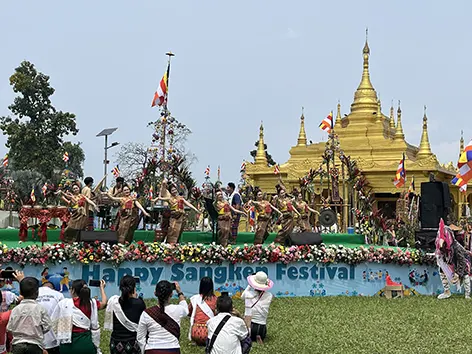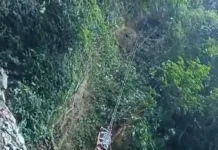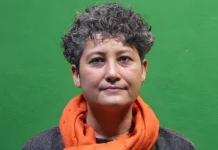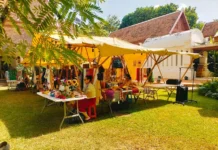[ Mrinal Talukdar ]
When we set out on our Long Loop Road Trip — a ten-day, 1800-kilometer self-driven journey around the Brahmaputra Valley — we expected landscapes, rivers, and a touch of adventure.
What we didn’t expect was to encounter the living force of one man’s vision — a man who has transformed not just a festival, but the cultural identity of a people.
That man is Chowna Mein, Deputy Chief Minister of Arunachal Pradesh, and a proud son of the Tai Khamti community. His work in reviving and reimagining the Sangken festival and establishing the Golden Pagoda at Namsai stands as a rare example of cultural stewardship in modern India.
We arrived at Ketetong, a Singpho village near Margherita, two days before Sangken began. Monasteries at Ketetong and Imthen were abuzz with activity — bamboo water chutes being assembled, shrine halls cleaned, idols readied for the ceremonial bathing. There was something serene yet electric about it —
like the calm before an an-
ticipated celebration.
By afternoon, we had crossed into Arunachal and checked into the Golden Pagoda Resort at Namsai, as the full moon rose over the majestic Golden Pagoda. Bathed in golden light against the silver night sky, it was a surreal sight — not just for the architecture, but
for what it symbolized.
The Golden Pagoda: A Vision Forged in Gold
Built under the patronage of Chowna Mein in 2010, the Golden Pagoda, or Kongmu Kham, is more than a place of worship. It is a statement. Inspired by Thai and Burmese Buddhist architecture, the pagoda has become the spiritual and cultural heart of the Tai Khamti people and a magnet for tourists, pilgrims, and scholars alike.
What began as a community effort to establish a religious center has, under Mein’s leadership, turned into a thriving complex of cultural preservation, education, and tourism. Today, it houses temples, guest houses, meditation centers, and a growing number of cultural exhibitions — blending the spiritual and the secular with effortless grace.
Sangken: A Festival Reimagined
The Sangken festival, celebrated in mid-April, marks the Tai New Year. Like its Southeast Asian cousins — Thailand’s Songkran, Myanmar’s Thingyan, and Laos’ Pii Mai — it centers on water, symbolizing purification, renewal, and joy.
But here, in Namsai, Sangken has evolved from a small ethnic celebration to one of India’s largest water festivals — thanks entirely to Chowna Mein’s unwavering commitment to his roots.
He has institutionalized the festival without letting it lose its intimacy. Under his guidance, Sangken is now formally inaugurated with community participation, state support, and cultural pride. We watched him lead the opening ritual — not from behind a podium, but in the thick of the crowd, throwing water, laughing with children, and blessing elders.
For three days, the streets of Namsai transformed into joyous rivers — filled with music, dance, laughter, and the spirit of togetherness.
Cultural Roots, Modern Reach
Beyond the fun and festivity, Sangken is a reaffirmation of cultural identity. In a rapidly globalizing world, small communities often face the erosion of language, ritual, and memory. But the Tai Khamtis — and their cousins, the Tai Phakes and Singphos — have defied that trend. And a significant credit goes to Mein’s lifelong mission to root development in cultural continuity.
He has helped ensure that traditional rituals — Lung Phra(bathing Buddha idols), community feasts, alms to monks, and bamboo shrine construction — remain not just symbolic, but lived.
Moreover, with Namsai’s improving infrastructure, accessibility from Dibrugarh airport, and the emergence of hospitality facilities, Sangken is poised to become a major cultural event in India’s festival calendar.
A Personal Journey, A Shared Awakening
Driving through this landscape with my wife — through misty riverbanks, quiet monasteries, and golden temples — I felt this wasn’t just a road trip anymore. It had become a journey through layers of heritage, where the personal met the political and the spiritual met the social.
We crossed the Lohit, Dibang, and Siang rivers — all tributaries of the Brahmaputra — but our hearts remained anchored at Namsai. Not just for its beauty, but for the remarkable story of one man and one festival.
Chowna Mein hasn’t just preserved a culture. He has revived it, reimagined it, and offered it back to the world — vibrant, inclusive, and alive.
And that, perhaps, is the biggest lesson of Sangken — that heritage isn’t what you protect behind glass. It’s what you pour water on, celebrate, and carry forward — bucket by joyful bucket. (The contributor is an Assam based senior journalist)




